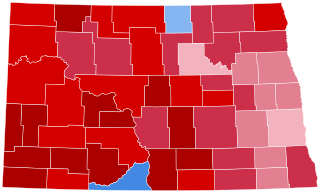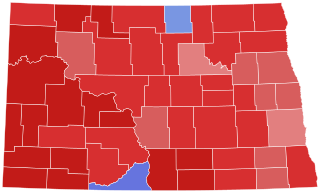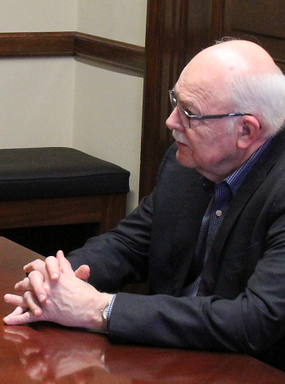
William "Wild Bill" Langer was a prominent American lawyer and politician from North Dakota, where he was an infamous character, bouncing back from a scandal that forced him out of the governor's office and into multiple trials. He was the 17th and 21st governor of North Dakota from 1932 to 1934 and from 1937 to 1939.

The 1962 United States Senate elections was an election for the United States Senate. Held on November 6, the 34 seats of Class 3 were contested in regular elections. Special elections were also held to fill vacancies. They occurred in the middle of President John F. Kennedy's term. His Democratic Party made a net gain of four seats from the Republicans, increasing their control of the Senate to 68–32. However, this was reduced to 67–33 between the election and the next Congress, as on November 18, 1962, Democrat Dennis Chávez, who was not up for election that year, died. He was replaced on November 30, 1962, by Republican appointee Edwin L. Mechem. Additionally, Democrat Strom Thurmond became a Republican in 1964, further reducing Democrats to 66–34. This was the first time since 1932 that Democrats gained seats in this class of Senators.

The 2012 United States Senate election in North Dakota took place on November 6, 2012, concurrently with the 2012 U.S. presidential election, other United States Senate elections, United States House of Representatives elections, and various state and local elections. Incumbent Democratic-NPL Senator Kent Conrad decided to retire instead of running for reelection to a fifth term.

From March 12 to May 17, 1940, voters of the Republican Party chose delegates to nominate a candidate for president at the 1940 Republican National Convention. The nominee was selected at the convention in Philadelphia, Pennsylvania from June 24–28, 1940.

The 1944 United States Senate election in North Dakota took place on November 7, 1944. Incumbent Republican Senator Gerald Nye ran for re-election to his fourth term. He faced a serious challenge to his renomination in the Republican primary, with prominent Fargo attorney Lynn Stambaugh and Congressman Usher L. Burdick running against him. He won with one-third of the vote, defeating Shambaugh, his closest opponent, by fewer than 1,000 votes. In the general election, Stambaugh continued his campaign against Nye as an independent, splitting the Republican vote as Governor John Moses, the Democratic nominee, ran a strong campaign. Though Nye had benefited from crowded general elections before, he bled Republican support to Stambaugh and Moses unseated him with just 45% of the vote. However, just a few months into Moses's term, he died in office, flipping the seat back to Republican control and triggering a June 1946 special election.

The 1932 United States Senate election in North Dakota took place on November 8, 1932. Incumbent Republican Senator Gerald Nye ran for re-election to his second term. He was challenged in the Republican primary by Governor George F. Shafer, but easily won renomination. In the general election, he faced P. W. Lanier, a 1930 Democratic congressional candidate. Even as Democrats were performing well nationwide, Nye had little difficulty winning re-election in a landslide.

A general election was held in the U.S. state of North Dakota on November 4, 2014. Five of North Dakota's executive officers were up for election as well as the state's at-large seat in the United States House of Representatives. Primary elections were held on June 10, 2014.

The 1906 South Dakota gubernatorial election was held on November 6, 1906. Incumbent Republican Governor Samuel H. Elrod ran for re-election, but was defeated for renomination at the Republican convention by former Attorney General Coe I. Crawford. In the general election, Crawford was opposed by the Democratic nominee, former State Representative John A. Stransky of Brule County. Crawford had little difficulty defeating Stransky in a landslide, largely matching Elrod's margin of victory from two years earlier.

The 2016 United States presidential election in North Dakota was held on Tuesday, November 8, 2016, as part of the 2016 United States presidential election in which all 50 states plus the District of Columbia participated. North Dakota voters chose electors to represent them in the Electoral College via a popular vote, pitting the Republican Party's nominee, businessman Donald Trump, and running mate Indiana Governor Mike Pence against Democratic Party nominee, former Secretary of State Hillary Clinton, and her running mate Virginia Senator Tim Kaine. North Dakota has three electoral votes in the Electoral College.

The 1938 United States Senate election in North Dakota took place on November 8, 1938. Incumbent Republican Senator Gerald Nye ran for re-election to his third term. He faced a strong challenge in the Republican primary from colorful Governor William Langer, but narrowly won renomination. Langer subsequently ran as an independent against Nye in the general election, and won the endorsement of the Nonpartisan League. The contest effectively sidelined Democratic nominee J. J. Nygaard, and the contest between Nye and Langer devolved into sharp disagreements about the United States's foreign affairs. Nye ultimately defeated Langer by a wide margin—winning 50% of the vote to Langer's 43%—but significantly reduced from his 1932 and 1926 landslides.

The 1950 United States Senate election in North Dakota took place on November 7, 1950. Incumbent Republican Senator Milton Young ran for re-election to a second term. In the Republican primary, he faced former Lieutenant Governor Thorstein H. Thoresen, who was endorsed by the Nonpartisan League. After winning the primary in a landslide, he faced State Senator Harry O'Brien, the Democratic nominee, in the general election. Aided by the national Republican landslide, Young defeated O'Brien in a landslide to win re-election.

The 2020 North Dakota gubernatorial election was held on November 3, 2020, to elect the Governor and Lieutenant Governor of North Dakota, concurrently with other federal and statewide elections, including the U.S. presidential election. Incumbent Republican Governor Doug Burgum and Lieutenant Governor Brent Sanford were both re-elected to a second term.

The 2018 United States House of Representatives election in North Dakota was held on November 6, 2018, to elect the U.S. representative for North Dakota's at-large congressional district. The election coincided with the U.S. Senate election, as well as other statewide, legislative, and local elections.

North Dakota held two statewide elections in 2018: a primary election on Tuesday, June 12, and a general election on Tuesday, November 6. In addition, each township elected officers on Tuesday, March 20, and each school district held their elections on a date of their choosing between April 1 and June 30.

The 1920 United States Senate election in North Dakota took place on November 2, 1920. Incumbent Senator Republican Senator Asle Gronna ran for re-election to a third term. However, he was narrowly defeated in the Republican primary by Edwin F. Ladd, the President of the North Dakota Agricultural College, who had been endorsed by the Nonpartisan League. In the general election, Ladd was opposed by H. H. Perry, the Democratic nominee and a Democratic National Committeeman. As Republican presidential nominee Warren G. Harding overwhelmingly won North Dakota over Democratic nominee James M. Cox, Ladd also staked out a wide victory—though his margin of victory was not as large as Harding's.

The 1926 United States Senate special election in North Dakota took place on June 30, 1926. On June 22, 1925, Republican Senator Edwin F. Ladd died in office. Governor Arthur G. Sorlie appointed Gerald Nye, a former congressional candidate and a prominent progressive activist, to fill Ladd's vacancy. A special election and regularly scheduled election were scheduled for the same year, though the special election, to fill the remaining months Ladd's term, took place months before the regularly scheduled election.

The 1926 United States Senate election in North Dakota took place on November 2, 1926. Following his re-election in the special election earlier in the year, Senator Gerald Nye ran for re-election to a full term. Despite spurning the Republican Party's endorsement in the special election, Nye ran in the Republican primary in the regular election. On the same day that he defeated former Governor Louis B. Hanna in the special election—in which Hanna had the Republican nomination and Nye ran as the Nonpartisan League candidate—Nye defeated Hanna in the Republican primary for the regular election. Nye once again faced a crowded general election, but emerged victorious in a landslide, winning nearly 70% of the vote while none of his opponents exceeded 15%.

The 2018 North Dakota Secretary of State election occurred on November 6, 2018, to elect the North Dakota Secretary of State, concurrently with various other state and local elections. Six-time incumbent Republican Secretary of State Alvin Jaeger was eligible to run for re-election to a seventh term in office, but withdrew from his party's primary after failing to receive the endorsement. When the primary winner withdrew from the general election race, Jaeger and fellow Republican Michael Coachman each gathered and turned in signatures to run as independent candidates. Libertarian Party candidate Roland Riemers failed to get enough primary election votes to make the general election ballot both in an initial count and in a court-ordered recount. Democratic-NPL state representative Joshua Boschee was the only candidate who advanced from the primary and the only candidate that had his party listed on the general election ballot.

The 2020 North Dakota Democratic presidential caucuses took place on March 10, 2020, as one of several states voting the week after Super Tuesday in the Democratic Party primaries and caucuses for the 2020 presidential election. While the contest has in effect been a party-run open primary for the first time in North Dakota's history, the state party retained the traditional caucus name, classifying it as a firehouse caucus. The state awarded 18 delegates to the 2020 Democratic National Convention, of which 14 were pledged delegates allocated on the basis of the results of the election.

Halvor Langdon Halvorson was an American politician and attorney who served as the mayor of Minot, North Dakota and later became a perennial candidate in North Dakota's congressional elections.





















